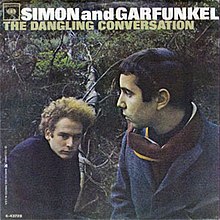| "The Dangling Conversation" | ||||
|---|---|---|---|---|
 | ||||
| Single by Simon and Garfunkel | ||||
| from the album Parsley, Sage, Rosemary and Thyme | ||||
| B-side | "The Big Bright Green Pleasure Machine" | |||
| Released | July 18, 1966 | |||
| Recorded | June 21, 1966 | |||
| Genre | Folk rock | |||
| Length | 2:37 | |||
| Label | Columbia Records | |||
| Songwriter(s) | Paul Simon | |||
| Producer(s) | Bob Johnston | |||
| Simon and Garfunkel singles chronology | ||||
| ||||
"The Dangling Conversation" is a song by American music duo Simon & Garfunkel, released in September 1966 as the second single from the duo's third studio album, Parsley, Sage, Rosemary and Thyme (1966).
Background
Simon & Garfunkel's opinion of the song varied over time. According to biographer Peter Ames Carlin, they both considered it their favorite song on the album at the time of its release. Marc Eliot, who wrote Paul Simon: A Life, disputes this, arguing that Garfunkel always disliked the song and felt it was pretentious. When the single did not perform as well as they had hoped, Simon told Record Mirror's Norman Jopling that the song was "above the kids." In 1993, when asked about the song, he commented, "It's a college kid's song, a little precious."
Reception
Cash Box said that it is a "gentle pop-folk ode which underscores some of life’s everyday hypocrisies" and expected it to "become a smash." Record World said that "the pretty tune with vivid lyrics of aloneness will catch."
Commercial performance
The song peaked at number 25 on the Billboard Hot 100, and never made it onto the UK charts. Simon viewed "The Dangling Conversation" as an "absolutely amazing" disappointment to him at the time, as the previous three Simon & Garfunkel singles were reasonable "hits". He felt as though the song may have been "too heavy" for a mainstream audience.
Charts
| Chart (1966) | Peak position |
|---|---|
| Canada 100 (RPM) | 27 |
| US Billboard Hot 100 | 25 |
| US Cashbox Top 100 | 15 |
In popular culture
The song features in Frederick Wiseman's 1968 documentary film High School in which a young teacher plays it, and enthusiastically advocates for its artistic qualities, while her class listens and looks rather bored. (As with all of Wiseman's work, the filmmaker's possible satirical intent always remains ambiguous.)
Cover
Joan Baez' album Joan in 1967. She changed the line "Is the theatre really dead?" to "Is the church really dead?".
References
- ^ Carlin 2016, p. 138.
- Eliot 2010, p. 74.
- "CashBox Record Reviews" (PDF). Cash Box. July 30, 1966. p. 20. Retrieved 2022-01-12.
- "Single Picks of the Week" (PDF). Record World. July 30, 1966. p. 1. Retrieved 2023-07-15.
- ^ "Simon & Garfunkel Chart History (Hot 100)". Billboard. Retrieved March 27, 2016.
- Jon Landau (July 20, 1972). "Paul Simon: The Rolling Stone Interview". Rolling Stone. No. 113. Retrieved May 27, 2016.
- "RPM Top 30 Rock Report". RPM. 6 (4). Ottawa: Library and Archives Canada. September 19, 1966. OCLC 352936026. Retrieved March 27, 2016.
- "Cashbox Top 100: September 10, 1966". cashboxmagazine.com. Retrieved 2021-01-25.
Sources
- Carlin, Peter Ames (2016). Homeward Bound: The Life of Paul Simon. Henry Holt and Co. ISBN 978-1-627-79034-5.
- Eliot, Marc (2010). Paul Simon: A Life. John Wiley and Sons. ISBN 978-0-470-43363-8.
| Simon & Garfunkel | |
|---|---|
| Studio albums | |
| Live albums | |
| Compilation albums | |
| Box sets | |
| Soundtrack albums | |
| Videos | |
| Discographies | |
| Other | |
| Simon & Garfunkel singles | |
|---|---|
| Sounds of Silence |
|
| Parsley, Sage, Rosemary and Thyme | |
| Bookends |
|
| Bridge over Troubled Water |
|
| Other singles | |
| Other songs | |